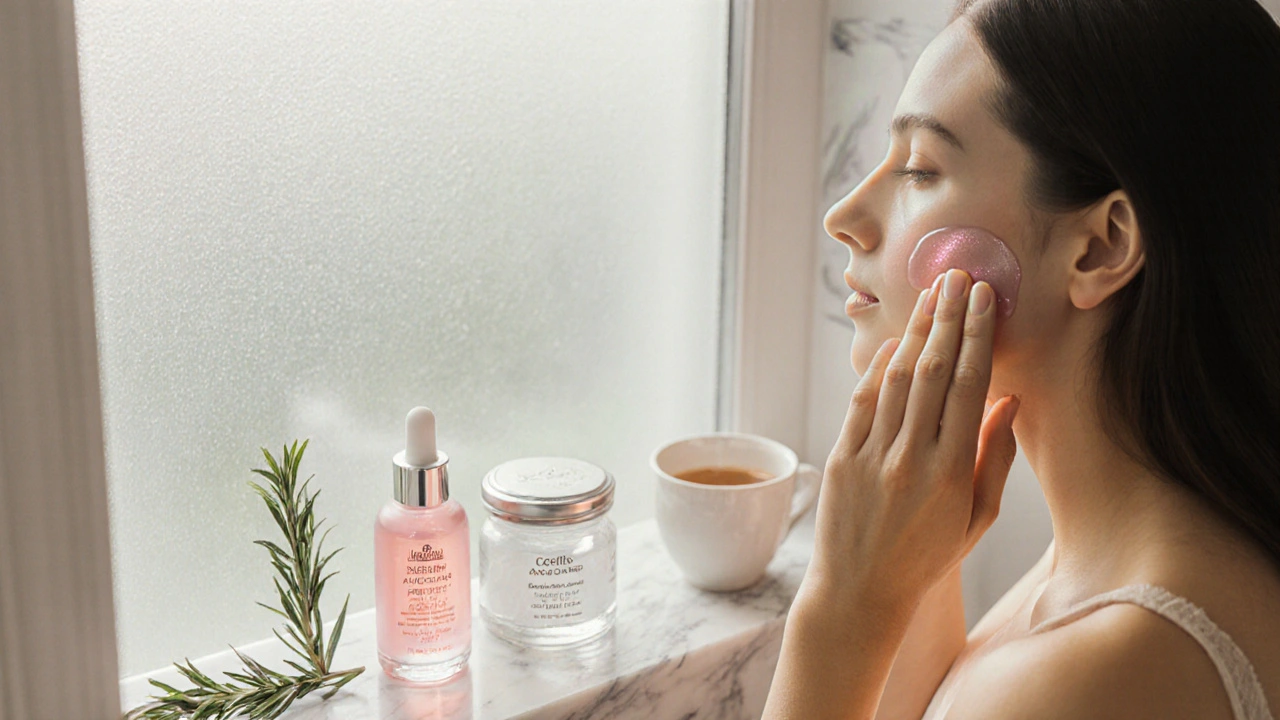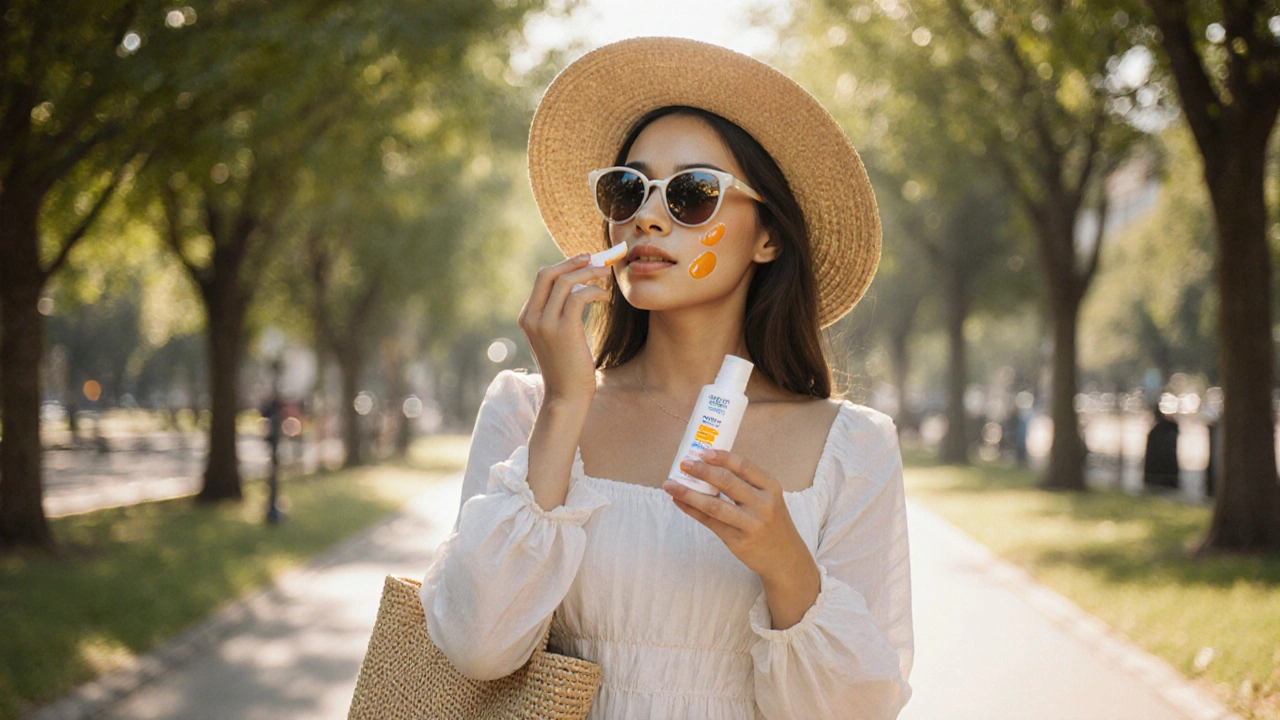TL;DR
- Sun UV rays stimulate melanocytes, worsening chloasma.
- Hormonal spikes (pregnancy, birth control) amplify the effect.
- Broad‑spectrum sunscreen (SPF30+, zinc oxide/titanium dioxide) is non‑negotiable.
- Wear UPF clothing, wide hats, and seek shade during peak hours.
- Topical antioxidants (vitaminC, niacinamide) help repair pigment damage.
What is Chloasma?
Chloasma is a form of melasma characterized by brown‑gray patches on the face, most commonly on the cheeks, forehead, and upper lip. It results from hyperactive melanocytes depositing excess melanin in the epidermis and dermis.
The condition affects up to 10% of women of reproductive age and 1‑2% of men, according to recent dermatology surveys. While it’s benign, the visual impact can cause significant emotional distress.
Why Sun Exposure Matters
Sun exposure refers to the skin’s contact with natural sunlight, which contains ultraviolet (UV) radiation. UV radiation is split into UVA (320‑400nm) and UVB (280‑320nm). Both penetrate skin, but UVA reaches deeper layers, directly stimulating melanocytes to produce melanin.
When UV rays hit already sensitive melanocytes-boosted by hormonal fluctuations-they over‑produce pigment, deepening existing chloasma patches and spawning new ones.
Who’s Most Susceptible?
Several factors amplify the sun‑chloasma link:
- Hormonal changes during pregnancy, oral contraceptive use, or thyroid disorders.
- Fitzpatrick skin types III‑VI (medium to dark) where melanin production is naturally higher.
- Family history of melasma or chloasma.
- Occupations or hobbies involving prolonged outdoor activity.
Even men with high UV exposure can develop chloasma if they have underlying hormonal imbalances.
Prevention Strategies That Actually Work
1. Choose the Right Sunscreen
Broad‑spectrum sunscreen blocks both UVA and UVB rays. Look for:
- SPF30 or higher (SPF50 recommended for high‑risk individuals).
- Active ingredients like zinc oxide or titanium dioxide for mineral protection.
- Water‑resistant formulation if you sweat or swim.
Apply 2mg/cm² (about a nickel‑size amount for the face) 15 minutes before heading out, and reapply every two hours.
2. Protective Clothing Beats Anything
Clothing with a UPF (Ultraviolet Protection Factor) rating of 30+ acts as a physical barrier. Wide‑brimmed hats, sunglasses with UV‑400 lenses, and long‑sleeve shirts reduce direct UV contact dramatically.
3. Antioxidant‑Rich Skincare
Topical antioxidants neutralize free radicals generated by UV exposure:
- VitaminC serum (10‑20% L‑ascorbic acid) brightens existing spots.
- Niacinamide (5%) improves skin barrier and reduces pigment transfer.
- Green tea extract and resveratrol have added photoprotective benefits.
Use these after cleansing, before sunscreen, to lock in protection.
4. Timing Your Outdoors
UV intensity peaks between 10a.m. and 2p.m. If possible, schedule outdoor activities outside this window. When you can’t avoid the sun, seek shade under trees, umbrellas, or built‑in awnings.
5. Hormone Management
If you’re on oral contraceptives and notice worsening chloasma, discuss alternatives with your healthcare provider. Women with thyroid disorders should keep hormone levels stable, as fluctuations can trigger pigment spikes.

Quick Daily Checklist
- Cleanse with a gentle, pH‑balanced cleanser. \n
- Apply antioxidant serum (vitaminC or niacinamide).
- Layer broad‑spectrum sunscreen (SPF30+).
- Reapply sunscreen after 80minutes of sweating or swimming.
- Wear UPF clothing and a wide‑brim hat if outdoors.
- Stay in shade during 10a.m.-2p.m. peak UV hours.
Common Pitfalls & How to Avoid Them
- Skipping sunscreen on cloudy days - up to 80% of UV rays penetrate clouds.
- Choosing a “cosmetic” sunscreen with low SPF - it may feel light but offers inadequate protection.
- Using only chemical filters - they can degrade under heat; mineral filters remain stable.
- Applying sunscreen after makeup - it can lead to uneven coverage; instead, use a sunscreen‑infused moisturizer or apply a setting spray with SPF.
Comparison of Popular Sunscreen Types
| Attribute | Mineral (Zinc Oxide / TiO₂) | Chemical (Avobenzone, Octinoxate) |
|---|---|---|
| UV Coverage | Broad‑spectrum (UVA + UVB) | Usually UVA + UVB, but depends on formula |
| Skin Irritation | Low - ideal for sensitive skin | Higher - may cause stinging for rosacea/eczema |
| Stability | Highly stable under sun & heat | Can degrade; needs stabilizers |
| Cosmetic Finish | Can be slightly white; modern nano‑formulas reduce this | Typically invisible |
| Recommended for Chloasma | Yes - offers consistent protection | Yes - if paired with antioxidant boosters |
When to See a Dermatologist
If patches persist after 8‑12weeks of diligent photoprotection, schedule an appointment. A dermatologist may recommend prescription‑strength hydroquinone, tranexamic acid, or laser therapy, but these are adjuncts-not substitutes for sun protection.
Frequently Asked Questions
Can I treat chloasma without sunscreen?
No. Sunscreen is the cornerstone of any treatment plan. Even prescription creams can worsen pigmentation if UV exposure continues.
What SPF is truly safe for chloasma?
SPF30 offers decent protection, but SPF50+ is advisable for high‑risk skin types or when you spend long hours outdoors.
Do antioxidants replace sunscreen?
They complement sunscreen by repairing free‑radical damage, but they do not block UV rays.
Is mineral sunscreen safe for daily use?
Absolutely. Mineral filters sit on top of the skin, provide stable protection, and are less likely to cause irritation.
How long does it take to see improvement?
Consistent photoprotection can lighten spots in 8‑12weeks, but deeper dermal pigment may take longer or require professional treatment.

